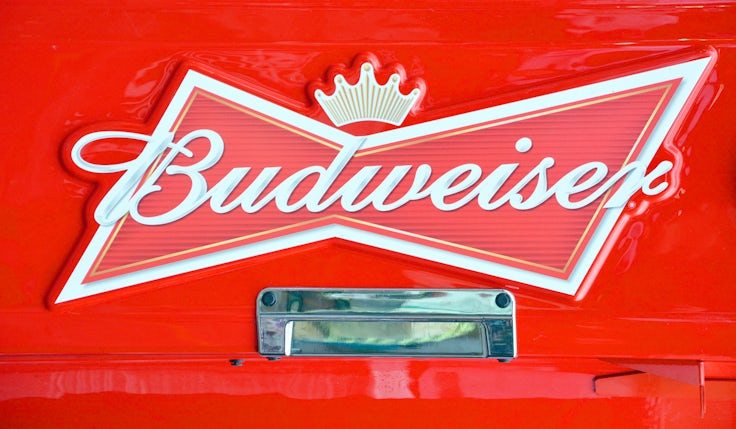AB InBev’s in-house agency on ‘democratising’ creativity across sales and finance
AB InBev’s in-house agency lead argues companies need to democratise creativity across all teams, not just marketing, in order to achieve business success.

Nearly four years on from launch, AB InBev’s in-house agency draftLine has been a key element of the drinks giant’s “transformational” work to embed a “creative culture” within the business, it says.
When DraftLine was launched in 2019 is was tasked with helping develop AB InBev’s overarching content strategy and creative for social, digital and out-of-home (OOH).
According to the agency’s founder and global vice-president, Tracy Stallard, draftLine has also helped to “democratise” creativity across the business and create stronger links between marketing, sales and finance.
“Having creativity at the centre of the business has been really transformational for us,” Stallard tells Marketing Week at the Cannes Lions Festival of Creativity this year.
“We have people from finance, sales and marketing all sitting at the same table, all having discussions about how we can be servicing consumer needs better,” she explains.
Building that cross-team relationship has also changed the nature of the work AB InBev is willing to do and the “risks” it is willing to take, she adds, pointing to last year’s Cannes Lions Grand Prix winning campaign, ‘Tienda Cerca’, as an example.
We expect our marketing team to be commercially savvy, and to understand what’s driving their business and how.
Tracy Stallard, AB InBev
The campaign was launched in 2020 during the Covid-19 pandemic, with the idea coming from within AB InBev’s sales team, which noticed that Colombia’s small stores (or ‘tiendas’) were struggling to bring in customers as they were afraid to leave their homes. Meanwhile, consumers were struggling to get the products they needed.
The Tienda Cerca app was quickly developed – an online delivery platform across a number of South American countries, which enabled shoppers to place online grocery orders with small shops at no cost to them or the business owner.
The campaign was “simple” and “very basic”, but responded to an “immediate need”, says Stallard, who is also AB InBev’s global vice-president of consumer experiences.
“There are people who have the title creative, but at the end of the day a company’s ability to be successful will be about how it democratises creativity in the business and unlocks it within a lot of individuals,” she argues.
AB InBev ‘increasingly’ looking to buy media on attention over CPM
Aligning with finance
Meanwhile, the in-house agency is also managing to stay “in lock step” with finance by continuing to develop its “test and learn skill”. AB InBev is now doing more pre-testing as a result, to determine how successful a campaign will likely be in advance.
“When we think about investment in the business, it’s a cost and return exercise,” Stallard explains.
“So the CFO is very aligned with us in terms of [understanding that] if we invest into a campaign and that’s going to generate more sales for us as an organisation, that’s a great investment.”
Suggesting that some marketers “chase in the wrong direction” when it comes to creativity in advertising, Stallard says as a “measurement-based organisation”, AB InBev has developed several mechanisms to help ensure its work is not only creative, but produces business results.
Marketing is getting complicated. There are a lot of skillsets and a lot of types of talent that are required in order to build successful brands today, and even more so going into the future.
Tracy Stallard, AB InBev
One of these tools is a ‘creative spectrum’, which is used by AB InBev around the world to create benchmarks and set growth targets for individual marketers.
“We believe we need to be able to measure things in order to move them,” Stallard says, adding that the draftLine team now also closely tracks sales performance.
“That’s something we’re working really hard on as we further integrate our marketing team into other parts of the company,” she says. “We expect our marketing team to be commercially savvy, and to understand what’s driving their business and how.”
Indeed, in February CEO Michel Doukeris described creativity to investors as “a lever to drive incredible success”, as AB InBev reported top line revenue growth of 15.6% for its 2021 fiscal year, and EBITDA growth of 11.8%.
The company was also awarded the ‘creative marketer of the year’ title by the organisers of the Cannes Lions Festival of Creativity this year, for its “reputation for producing brave creative and innovative marketing solutions”.
AB InBev restructures with new CMO to report into chief growth officer
Founding the agency
Reflecting on the early days of draftLine, Stallard says the ideas was sparked when, as AB InBev’s head of US media, she noticed the company was “missing opportunities” around connecting data-driven media buying with “consumer understanding”.
She says: “I saw we had a disconnect between how we were thinking about content development and how we were thinking about using media to optimise our content.”
So the agency was founded with four key objectives in mind, including more effective use of insight in creativity, and to act as the “glue” linking consumer understanding, creativity and media engagement.
“For us, creativity is not only about how we think about the amazing new equity campaign we want to launch,” Stallard says, explaining that it is about how the campaign is brought to life in the brand’s DTC channels, in-store, and in physical experiences.
“It’s about how we become creative holistically, rather than just with a specific TVC,” she adds.
The third objective was to move AB InBev from being a company known for mergers and acquisitions to being a company focused on organic growth, which included making creativity a “core advantage” of the business.
“To do that we needed to start treating creativity as a competitive advantage and to have creative people close to the business, so we can really utilise everything that’s in the company,” Stallard says.
The final objective was to bring a “new type of talent” into the business’s marketing function that would be more specialised in nature, including media buying talent, audience data specialists and creative strategists. Stallard says these skills had never been hired on the brand teams in the past.
“Marketing is getting complicated. There are a lot of skillsets and a lot of types of talent that are required in order to build successful brands today, and even more so going into the future,” she says.
“So for us it was all about future proofing our marketing team and propelling us forward to the type of talent we would need five to 10 years down the line.”
Since launched in 2019 with a sparse team, draftLine has grown rapidly. By 2020 the agency had quadrupled in size, and now has more than 500 individuals working in 13 studios all over the world.
However, bringing specialities in-house hasn’t eliminated the need for external agency partnerships, especially when it comes to bigger brand projects like a repositioning.
“[Founding draftLine] was not about the ‘or’ but the ‘and’, and how we start to build the things we didn’t have to complement the things we had,” Stallard explains.
“What we try to do is bring those people together, create new ways of working and thinking, and ultimately develop ecosystems for our brands that fulfil consumer needs.”








Comments